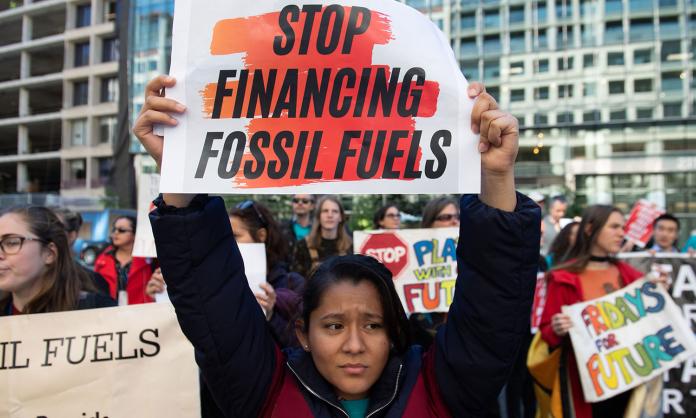“Green banking” is one of the ethical consumption fads of the day. No-one should be under the illusion, however, that it’s any more able to combat climate change and environmental destruction than any of the other failed consumer-oriented approaches of recent decades.
The fad is impossible to avoid. From regular columns in the “Moral Money” section of the Financial Times and “sponsored content” in the Guardian, to giant billboards pitching banking services to those “who believe money should be used for good” and super funds boasting that they “won’t be caught funding the climate crisis”—green banking is everywhere. According to its proponents, it can, and should, be in the banks’ interests to drive a green transition, and we can force them into it if only we exercise our power as consumers by directly pressuring them or moving to a supposedly “greener” bank.
Extinction Rebellion (XR) recently joined the green banking crusade, targeting National Australia Bank (NAB) branches around the country. NAB was singled out for its brazen celebration last year of ten years of “carbon neutrality”, despite continuing to pour money into fossil fuels. Along with occupations of NAB branches, XR has argued for climate activists to petition their local bank branch managers or switch to Bank Australia (of “money should be used for good” billboards fame).
Banks are, no doubt, starting to feel some pressure to adopt a more outwardly green stance. NAB’s highly dubious carbon neutrality claim is one example. The Commonwealth Bank of Australia provides another. In 2015, seeking to help the bank recover from a number of scandals and navigate growing competition, CBA then chair David Turner set about rebranding it as “the ethical bank”. Part of the rebrand involved publicly committing to tackle climate change by influencing the companies it was financing.
Yet there’s a big difference between projecting a green image and actually dropping investments in fossil fuels. A new report led by the Rainforest Action Network (RAN)—Banking on Climate Chaos—shows the extent of the problem. The report examines fossil fuel financing from the world’s 60 largest commercial and investment banks. Australia’s “big four”—CBA, NAB, ANZ and Westpac—all made the list of the planet’s best-dressed arsonists.
The news isn’t good. Take CBA for example. Despite loudly pronouncing its new-found ethical and green credentials in 2015, when it comes to fossil fuel financing, it hasn’t even broken stride. The bank’s total investment in fossil fuels was higher in 2020 than it was in 2016, and it contributed a total of US$6 billion between 2016 and 2020. Together, Australia’s “big four” have doled out US$32 billion of fossil finance in that time.
“The solution is simple”, green banking advocates might say. “If you don’t like those banks, move your money elsewhere.” The sheer size of the banking giants, however, means campaigns like XR’s amount to trying to drain the ocean with a bucket. Together, the “big four” hold A$3.8 trillion in assets—nearly three times Australia’s GDP—and, according to a 2018 report by the Productivity Commission, they control 80 percent of the Australian market in home loans, mortgage insurance, reinsurance and travel insurance.
Just as choosing to shop at your local greengrocer isn’t going to put much of a dent in the dominance of Coles and Woolworths, neither is shifting your savings, your home loan or your superannuation to a supposedly “green” alternative like Bank Australia going to give much pause for thought to the “big four”.
It’s even clearer on a global level. If Australian banks play with matchsticks, the global banking giants play with napalm. The RAN report found that the world’s top 60 banks collectively poured US$3.8 trillion into fossil fuels between 2016 and 2020. There’s no downward trend either: fossil fuel financing was higher in 2020 than in 2016. If anyone knows the best interests of the banks, it’s the bankers, and they’ve made it clear: they’re banking on fossil fuels.
As with Australian banks like CBA and NAB, this doesn’t mean banks won’t do their best to project a “green” image to the public. Of the 60 banks examined in the report, eleven were signatories to the UN’s Collective Commitment to Climate Action, seventeen had recently pledged to achieve “net zero” financed emissions, and twenty have since become signatories to the UN’s Net-Zero Banking Alliance. Again, however, the financing figures tell a different story, and, as the report notes, “for many of the world’s worst funders of fossil fuels, these plans so far are dangerously weak, half-baked, or vague”.
A report released in April by DeSmog helps explain why. Examining 39 banks around the world, it found 368 out of 565 directors had past or current connections to the fossil fuel industry. This should come as no surprise. The world’s banking giants are among the most important institutions of global capitalism. It makes sense, therefore, that they would be run by people with experience in fossil fuels, which are arguably—from a ruling-class perspective—the system’s most important industry.
Fossil fuels not only remain highly profitable, for both the industry itself and those who finance it. They are also crucial to many of the things the global capitalist class holds most dear, like waging war, for instance.
For bankers and other capitalists, there’s no alternative to the reality we are in—certainly not in the time span real climate action demands. To turn a profit and stay ahead of their rivals, the bosses have to embrace the economy basically as it stands—filled not only with coal mines, petrol vehicles and gas-fired power plants, but also with fossil-fuel-hungry industries like the military and construction.
For our side, there is an alternative: turning every workplace, bank, factory, farm, supermarket and power station on its head so that workers, not the servants of capital, can decide our fate. “Green banking” might make you feel good, but it isn’t going to get us a step closer to that goal.








